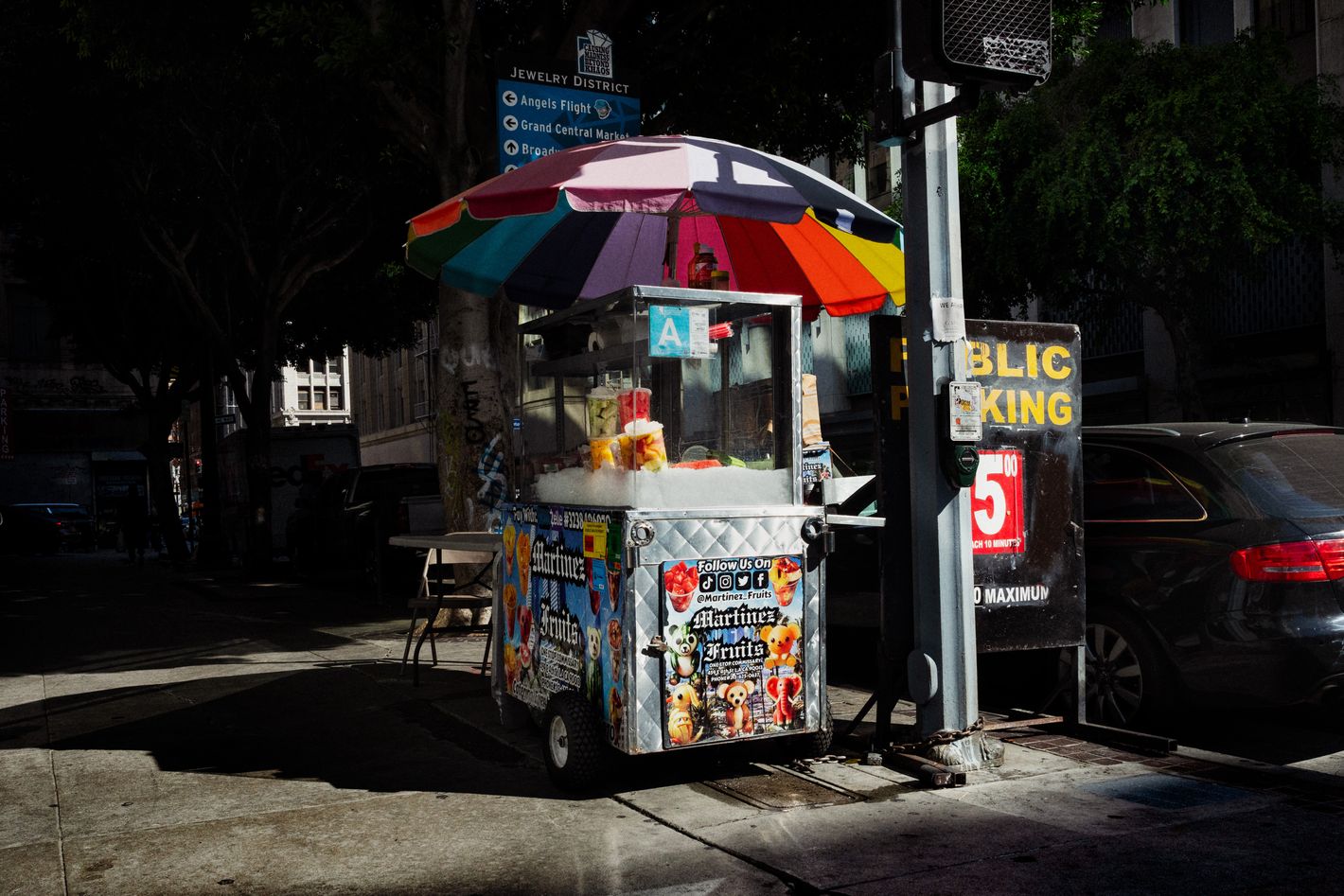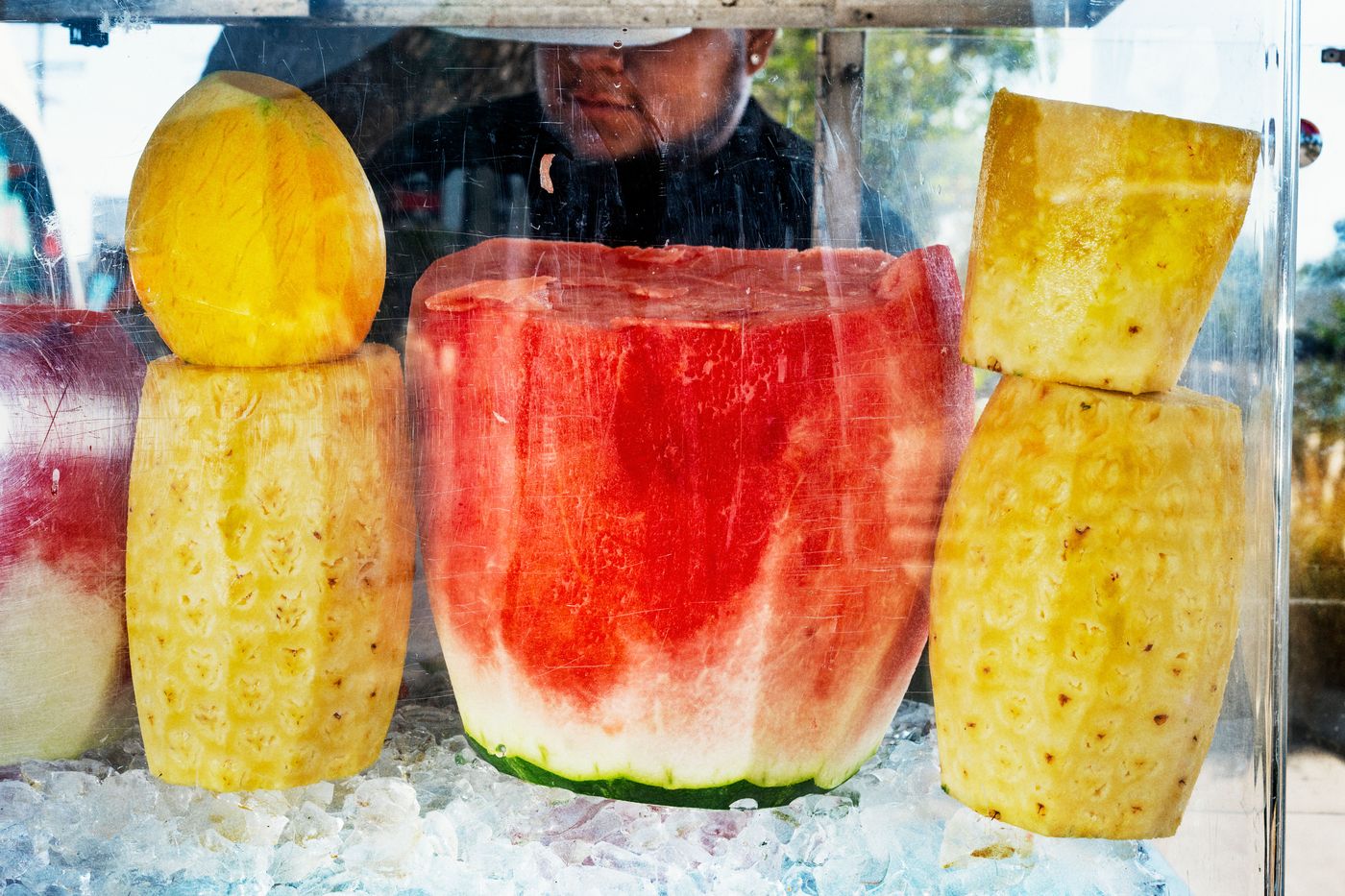when you want, where you want.
CJ Television
What Los Angeles Loses Without Its Fruteros
 Photo: Ethan Noah Roy
Photo: Ethan Noah Roy
On a sidewalk outside a Home Depot in Cypress Park, Los Angeles, a few weeks ago, a fruit vendor was standing under his rainbow-stripe umbrella, which wasn’t doing much to protect him from the sun. “What are you feeling like right now?” he asked. “You like Tajín, lime, chamoy?”
He got to work carving honeydew into wedges, fresh coconut into crescents and watermelon into cubes, seasoning everything with shakes of Tajín and splashes of lime before scooping it all into a plastic cup sealed with a sturdy plastic fork tied into the knot of the bag.
Watching a frutero work can feel like taking in a great performance in just a few minutes. El Ninja, a vendor who livestreams his lunch rush near a nondescript Chase bank in La Puente to some 6 million followers, is quick with the santoku and regularly gets visitors from India and Japan. “Customers want to see the fruit cut in front of them because that provides an element of freshness,” says Dr. Rocío Rosales, author of Fruteros. “And they have to prepare it quickly because some people are literally waiting for a bus — they’re always going to choose the bus over the fruit.”
It was surprising that this particular vendor was back at all. A few days earlier, an immigration raid led by teams of masked men with assault rifles had swept through the parking lot. “The day it happened, we weren’t here,” said the vendor. “As soon as ICE showed up, the other fruit vendors left. They left everything.” He says he and another frutero who work the same spot on alternating days went back to survey the scene to see whether ICE had returned. “There’s a group text, so we all know when someone sees them coming.”
Fruteros try to stand out by design so potential customers can spot them. “Everybody who knows L.A.,” says Rosales, “knows a fruit vendor.” And they are uniquely vulnerable to raids. “When they’re all set up, fruteros are alone, which makes them targets,” says Bill Esparza, the L.A. food writer and podcast host. In the city and its surrounding areas, at least ten fruteros have been abducted since June 6. In the Westchester neighborhood, one was pushed onto the pavement where he had sold fruit for years. In La Puente, a frutero was whisked into a white SUV by two men wearing inscrutable badges on lanyards. The same men abducted another vendor in Pomona. Immigration authorities took several people from Rosemead Boulevard in El Monte, and a solitary frutero in Norwalk Town Square was taken by someone in full tactical gear. Downtown, a woman reached for a lamppost as she was being dragged away. The wholesale market where fruteros buy produce was itself emptied out after the raids started.
Between June 6 and last week, immigration authorities arrested 4,600 people in the L.A. area. Most were men who worked at car washes, factories, and in construction. But a disproportionate number of the food vendors confronted and abducted by immigration authorities have been women. One tamalera was thrown to the ground and lost consciousness. Another was a taquera who clung to a jacaranda tree before masked men forced her into a car and drove off, tossing tear gas into the street.
To outside observers, it may appear that the wave of arrests that ramped up in June is over. A temporary restraining order that challenged the tactics of immigration authorities is still in place. The Pentagon released about 4,700 National Guard members in the past month, leaving 300 here, and the Justice Department is in court this week to defend their deployment. But the arrests, carried out by Customs and Border Protection and Immigration and Customs Enforcement, continue, including at the Home Depot in Cypress Park.
 Photo: Ethan Noah Roy
Photo: Ethan Noah Roy
Esparza says a pervasive fear has obliterated Latino food culture wherever he goes, a dozen or more places a week. Carts sit empty, and public parks are desolate without vendors. Esparza estimates that sales are down 90 percent across the board. “That number is not an exaggeration,” he said. “It’s 90 percent of sales when you count places that are just closed or vendors staying in, plus the ones that are still open and making just $10 for the whole day.”
“I can’t make money now,” a vendor in Arlington Heights confirmed, telling me he’d served only two customers in an hour. “But I’m here. I can’t hide forever.”
Like New York’s sidewalk vendors, fruteros have always needed to exercise some degree of caution. “Formerly, the consequence was a fine or confiscation of tools or, in the worst case, a seized cart,” explains Rosales. Most vendors just evaded the city workers and returned the next day. The numbers of fruteros increased after California decriminalized street vending in 2018. Reduced permit fees and the reversal of a ban on vending at tourist sites also helped encourage more vending. The threat of imprisonment and deportation have changed the calculation considerably. “It’s not the system of a few years ago,” Rosales says. “The idea that someone might be picked up and shipped to South Sudan, you know? It boggles the mind, but it also increases the cruelty of it.”
There is at least some help: The nonprofit group CIELO works with Indigenous Mexicans and Central Americans and provides food and linguistic assistance to those who can’t work, as well as to families of detainees. “Indigenous people are being kidnapped the most, and nobody talks about that,” says CIELO executive director Odilia Romero. Most fruteros come from the Mexican state of Puebla, but at least two of ten arrested since June are Guatemalan and Indigenous. More than a dozen languages (Ixil, Q’eqchi’, Mixteco) are spoken in this community by people who may be unable to navigate legal hearings. “Some are just signing paperwork because they’re scared, but most of the people who were kidnapped are Indigenous,” Romero adds. “Language barriers play a big role in that.”
A separate coalition called the LA Street Vendor Solidarity Fund has so far raised $200,000, and a stopgap strategy has emerged: buying out vendors in an effort to get them off the street. Someone approaches fruit or flower vendors who sell from medians or off-ramps with a short stack of cash for their entire inventory. La Pawnadería, a Downey dog bakery that is resolutely and cheekily modeled on a panadería, buys out vendors directly with proceeds from its “Chinga La Migra” bandannas and biscuits. “The first person we met was a 70-year-old flower vendor who also sold oranges and peanuts,” says owner Adriana Montoya. “He’d had surgeries and was dealing with a tumor. He explained to us that he worked to take care of his wife, who was also disabled.”
The buyouts are optimized for social media, but they’re still helping, even if they’re not sustainable in the long term. It makes everyone who follows the vending scene in L.A. nervous. “The fruteros, these street vendors, they’re here for us because we want them here,” Esparza says. “I want to be able to hear the guy outside my window, three blocks away, honking, using his bike horn, letting me know to come out and come out and get something good to eat.”
This post was updated to clarify the status of the market where vendors buy ingredients.
Related
All Rights Reserved. Copyright , Central Coast Communications, Inc.